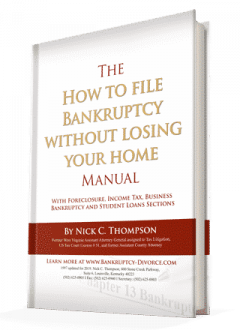Voluntarily dismissing a Chapter 13 109(g)(2) and refiling in hopes of a second chance has specific problems you need to know about. Problems can continue to happen to good people after they file Chapter 13 to attempt to keep their homes. Perhaps you filed Chapter 13 in good faith hoping to make the payments. However, you may have later fallen behind again due to disability, divorce, death in the family, or other problems.
Voluntarily Dismissing a Chapter 13 109(g)(2) and Refiling
If you fall behind in paying the mortgage after filing chapter 13, the lender will file a motion to terminate the stay. If they are successful and go back to foreclosing, there may be no reason to continue the bankruptcy. In those circumstances, you may need to dismiss the Chapter 13 case and refile. However, the problem is that you are only allowed one bite at the apple.
Then, if you dismiss a Chapter 13 case and file a second petition you normally must wait over six months before you refile the second case. During that time if you don’t or can’t delay the foreclosure, the house will be sold. Sometimes you can refile, and the bank doesn’t object. But you are taking a big risk that the second case will be dismissed.
Refiling a second petition within 180 days after a motion for relief of stay.
Most mortgage companies want the mortgage payments they don’t want the home. However, a few lenders and many servicers do not operate on the goal of making the payments on time. If you don’t make the payments on time they charge additional fees. Especially servicers operate on these fees and they milk accounts for all the money they can get in late fees, penalties and interest. For some they make more money on forced placed insurance and escrow fees than they make from the loan. They want to foreclose.
Many lenders will not object if you file a second case after a motion for relief from stay. Some servicers and attorneys however will object so they can increase their attorney fees in the case and servicing fees. While this may increase the loss to the taxpayer or lender it increases their profits. If they object, the court may be required to dismiss the case. In some districts, you may get away with a second filing. It becomes like sneaking through the cave to get a second case confirmed.
Take a second bite of the apple and the mortgage bites back.
Congress enacted section 109(g)(2) to stop the abuse of repeated bankruptcy filings. If you attempt to refile you have given the bank 180 days in state court to finish a foreclosure. Section 109(g)(2) provides that an individual may not be a debtor: “if the debtor requested and obtained a voluntary dismissal of a previous bankruptcy case at any time in the preceding 180 days.”
The purpose of the statute was to prevent abuse. However, to not allow a second bankruptcy becomes absurd under some circumstances. For instance, debtors don’t plan heart attacks with the intent of not paying their mortgage. The purpose of the rule was to stop the abuse of repeat filings. In some cases, enforcing the 109(g) rule harms the creditor, the debtor, taxpayers, and local homeowners. The courts have taken three different positions on 109(g).
The three 109g tests to voluntarily dismissing a Chapter 13 109(g)(2) and refiling.
Some judges believe the court must mandatorily dismiss any Chapter 13 filed within 180 days after voluntarily dismissing a prior Chapter 13. These courts look at it as an eligibility requirement In re Andersson, 209 B.R. at 78. However, dismiss your own case and you are ineligible to file bankruptcy.
Others look to see if there is a causal connection. For instance, was there an event or cause which damaged the debtor and caused the failure of the Chapter 13 plan? If there is some reason or cause completely unrelated to the motion for relief from stay, the court can choose to allow the second case. In re Duncan, 182 B.R. 156, 159 (Bankr. W.D. Va. 1995).
Other courts use common sense and use their discretionary approach. In re Hutchins 303 B.R. 503, 505 (Bankr. N.D. Ala. 2003). The circuits are not uniform, and you may find different judges within the same district using different approaches. Even the same judge might not be consistent. The debtor can file a second case and often it is approved anyway. But the debtor is taking a risk. So, if you’re having problems see us for real answers. Be sure to see this article on Voluntarily dismissing and refiling Chapter 13.
 Resources for Bankruptcy
Resources for Bankruptcy
Louisville Kentucky Bankruptcy Forms
Debt Settlement and Debt Relief Attorney
Chapter 13 Modification, Conversion, Refiling and Early Discharge
Avoiding Foreclosure with Bankruptcy
If you are thinking about filing bankruptcy, don’t delay because timing is crucial. I am here to help you. So, contact my office right away to start the conversation. Nick C. Thompson, Bankruptcy Lawyer: 502-625-0905.



